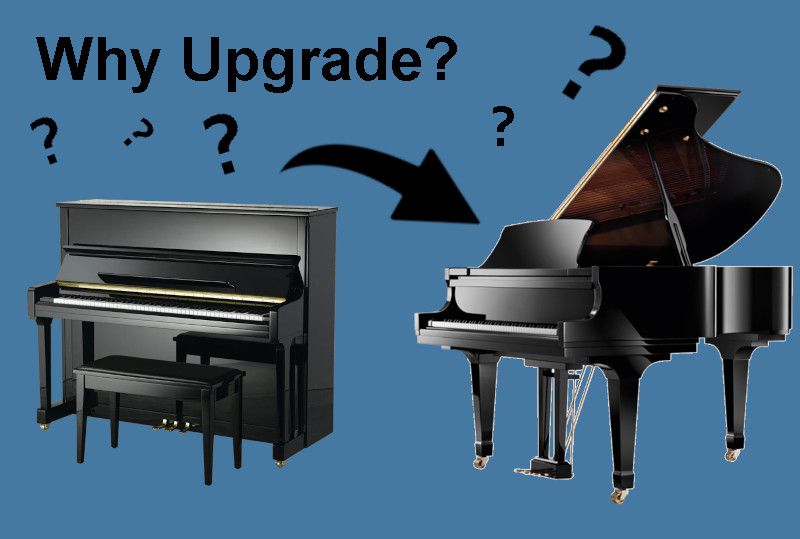
I’ve heard this statement many times. In fact it happened when I was a young. The piano teacher states, “Your children are at a level now where it would be helpful to have them practice on a grand piano”. But is there any substance to this statement? Is there validity in upgrading to a grand piano? Is there empirical data that proves the advantages of a grand piano? In short, the answer is yes. Let’s take a look at what makes grand pianos so… grand! There are 5 main differences between upright and grand pianos.
First, grand piano keys are longer. Why do long keys matter? One common statement that I’ve heard many times is that grand pianos are somehow heavier to play. By design, grand pianos shouldn’t feel heavier than upright pianos. If they do feel excessively heavy, it may be caused from undue friction, a poor design or an action that hasn’t been weighed off properly. Grand pianos and upright pianos should both feel comfortable to play. But there is one aspect of grand piano touch which is superior and that has to do with evenness. It relates to part of the key that you can’t see and so I took 3 keys out of 3 different pianos to demonstrate. Pictured below are 3 keys sticks – one from a medium sized 5’8″ grand piano, a tall 52″ upright piano and a short 40″ upright. As you can see, the white keytops look the same on all of the pianos. So if the keytops are the same, how are they different from upright to grand? I’ve lined these up so that you can see the distance from the “balance rail holes” – those are the slots on the right side of the key. The grand key is much longer than upright piano keys. The further away the keytop is from the balance point, the less variation there will be in the keys from front to back. Piano keys operate like a child’s see-saw. When you push down at the front, the back of the key goes up. If you have someone sitting on the other end of a see-saw, you would need an equal weight at equal distance to balance, correct? But as you move to the center, it requires more weight to balance the other side. So too in pianos, as your finger moves from the front of the key to the end, there will be some variation in touch. Grands simply do this better because the keytop is further from the balance point. Trust me when I say that short piano keys are not your friend. There is too much variation in the touch from the front to the back of the key. 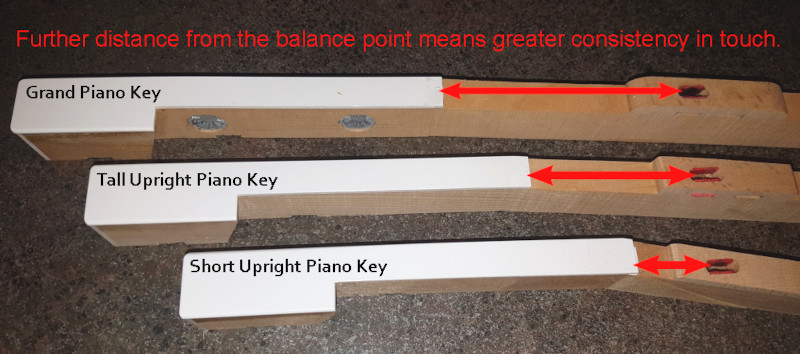
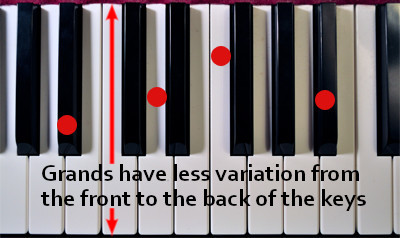
B Flat Chord Finger Placement
As an experiment, the next time you sit at a piano, see if you can feel the change in pressure required to push the key down at the tip of the key and then at the end of the key. Because the grand keys are longer, the balance rail is further and there is less variation in performance. And some may ask, “But don’t you simply press the keys down at the fronts of the keys?” Not at all. If you play, for example a B flat 4-note chord, your finger positions would be roughly positioned where the red dots are in the picture. See how some finger positions can be really close to the back of the key than others? One of the greatest advantages, then of grand pianos is low key variation.
 Second, there is the matter of repetition. As the word implies, repetition refers to how quickly a key can repeat. Recently I was introduced to Robotran. Robotran is a company located in Belgium that analyzes piano actions through mechanical modelling. This multibody dynamic approach gives insight into how efficient piano actions are in repeating. They start with a real piano action and film it at 2000 frames per second. Then with sensors in place, they make a virtual model. In a recently published paper, Robotran found that grand pianos consistently outperformed upright piano repetition in both virtual and physical testing. Where grand pianos really shine, however is in half-key repetition. This means that the key does not need to reset all the way back up when repeating.
Second, there is the matter of repetition. As the word implies, repetition refers to how quickly a key can repeat. Recently I was introduced to Robotran. Robotran is a company located in Belgium that analyzes piano actions through mechanical modelling. This multibody dynamic approach gives insight into how efficient piano actions are in repeating. They start with a real piano action and film it at 2000 frames per second. Then with sensors in place, they make a virtual model. In a recently published paper, Robotran found that grand pianos consistently outperformed upright piano repetition in both virtual and physical testing. Where grand pianos really shine, however is in half-key repetition. This means that the key does not need to reset all the way back up when repeating.  You can actually re-strike the note halfway up. In essence, the key no longer needs to return to full resting position before repeating. While both uprights and grands can repeat quickly, it was proven with Robotran that grand pianos do so more quickly. The numbers in the graph are represented in Hertz. Many thanks to Robotran for this contribution. As you can see, upright piano repetition peaks at around 13 times per second while the grand is greater than 20. Conservatively, the grand outperforms in speed by 35% or more.
You can actually re-strike the note halfway up. In essence, the key no longer needs to return to full resting position before repeating. While both uprights and grands can repeat quickly, it was proven with Robotran that grand pianos do so more quickly. The numbers in the graph are represented in Hertz. Many thanks to Robotran for this contribution. As you can see, upright piano repetition peaks at around 13 times per second while the grand is greater than 20. Conservatively, the grand outperforms in speed by 35% or more.
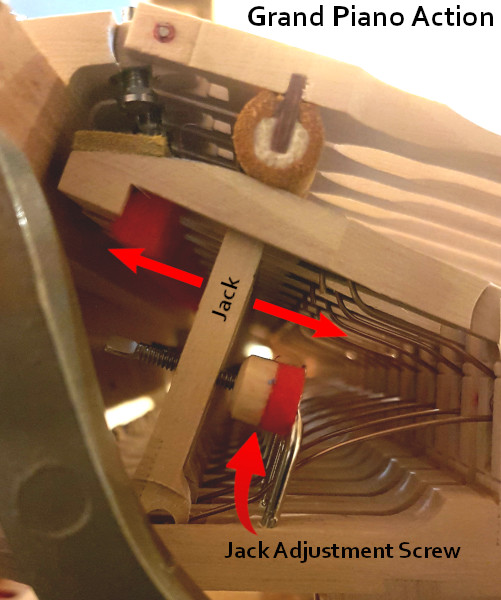 Third is adjustability. Grand pianos simply have more adjustable components than upright pianos. But does adjustability mean superior? In short, yes. There are aspects of grand actions that simply aren’t available on upright pianos. And while it could be argued that well-prepared upright pianos can rival grand touch, the fact remains that grand pianos can be readily “tweaked” through adjustment screws. For example, in areas relating to repetition and escapement, both grands and upright pianos have a “jack”, but only grand pianos have an adjustment screw for positioning. This simple adjustment can affect subtleties in touch. Further back and the jack has more “grab” on the leather knuckle and can allow the performer greater control of repeated notes. If it’s positioned too far back, it can feel like there’s too much friction or have problems repeating. Conversely, if the jack is slightly forward, it can feel quicker but too far forward slips the jack out too soon and can feel like a loss of power. Subtleties in this position give very different touch feedback to performers. This is just one screw but it is very significant. Grand pianos simply have more options for customization that can be manipulated more readily than their upright counterparts. Having said this, a high end upright piano functions incredibly well when set up properly and most pianists would be hard-pressed to maximize professional upright touch potential.
Third is adjustability. Grand pianos simply have more adjustable components than upright pianos. But does adjustability mean superior? In short, yes. There are aspects of grand actions that simply aren’t available on upright pianos. And while it could be argued that well-prepared upright pianos can rival grand touch, the fact remains that grand pianos can be readily “tweaked” through adjustment screws. For example, in areas relating to repetition and escapement, both grands and upright pianos have a “jack”, but only grand pianos have an adjustment screw for positioning. This simple adjustment can affect subtleties in touch. Further back and the jack has more “grab” on the leather knuckle and can allow the performer greater control of repeated notes. If it’s positioned too far back, it can feel like there’s too much friction or have problems repeating. Conversely, if the jack is slightly forward, it can feel quicker but too far forward slips the jack out too soon and can feel like a loss of power. Subtleties in this position give very different touch feedback to performers. This is just one screw but it is very significant. Grand pianos simply have more options for customization that can be manipulated more readily than their upright counterparts. Having said this, a high end upright piano functions incredibly well when set up properly and most pianists would be hard-pressed to maximize professional upright touch potential.
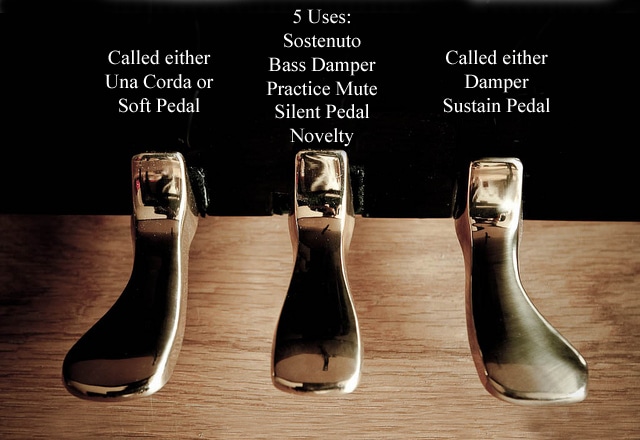 The fourth difference between grands and uprights is pedals. We have looked at all three of the pedals in depth in other articles. To recap, the sustain pedal (right) is used most of the time and it operates the same on grand and upright. It accounts for over 90% of usage. The soft pedal on the left and the middle pedal have quite different ways of operating on both grand and upright. We wrote an entire article on each pedal and the differences are lengthy so click the links above to get the full story on the differences between grand and upright pedals.
The fourth difference between grands and uprights is pedals. We have looked at all three of the pedals in depth in other articles. To recap, the sustain pedal (right) is used most of the time and it operates the same on grand and upright. It accounts for over 90% of usage. The soft pedal on the left and the middle pedal have quite different ways of operating on both grand and upright. We wrote an entire article on each pedal and the differences are lengthy so click the links above to get the full story on the differences between grand and upright pedals.
Fifth, the sound. I can’t state this one aspect enough. All upright pianos predominantly have tone reflected off of a wall. As a performer, this means you are listening to reflective tone. When sound reflects, the highest frequencies get absorbed the quickest and so the greatest difference between the grand piano and the upright piano is the lack of high frequencies and presence. Grand pianos have what I would call “double exposure” to the soundboard. You hear all of the sound directly in front of you as well as reflective sound from the floor. And while acoustics do play a part, hearing the complete spectrum of sound in front of you as you play, is the most significant part of the grand experience. Is it necessary? Absolutely not. It’s pure indulgence and luxury. There’s no greater joy than playing a grand piano.
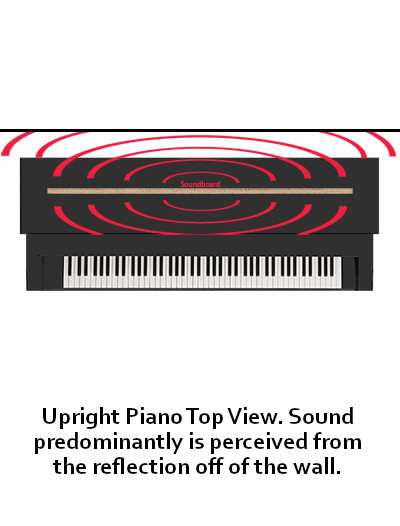
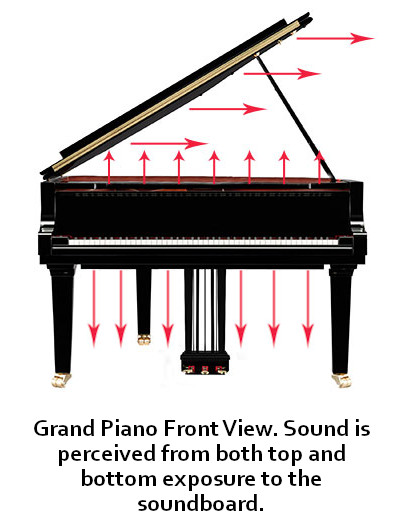
One question I get asked often, “But is a grand required for student development?” Required? No. An upright piano still has 88 keys that can play the same piece as a grand would. Is it advantageous? Yes insofar as I would venture to say that you feel more, you hear more and simply stated, you experience more. I truly believe that if there were more examples of fabulous grand pianos to play, more people would fall in love with the piano. It’s not a question of necessity but rather of passion and the pure enjoyment of performance.
More Piano Articles

You’ve been playing your piano for years now and the time has come to seriously consider downsizing the house and move into a condo. But what do you do with the piano? You love your piano and can’t imagine life without it and besides, you absolutely hate the idea of playing a digital keyboard. Many people don’t know that you can add digital functionality without compromising your existing piano. Yes, it is completely possible to ...
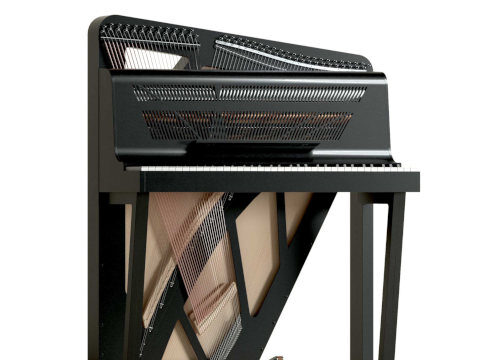
Many years ago, I remember seeing a piano in a museum similar to the one shown above (built in 1787 by Christian Gottlob Hubert. On display at Germanisches Nationalmuseum - Nuremberg, Germany). I have often wondered why acoustic portable pianos never really took off. Although we've seen more portable keyboard instruments like harpsichords, accordions or electronic keyboards, they operate completely different from a traditional piano in that they either pluck the strings, use air with ...

This was the first year since covid that the National Association of Music Merchants (NAMM) trade show was back to its regular January date and, in fact the first show where it felt back to normal. How was it? To answer that, I'm going quickly review the piano market over the last few years. Piano sales boomed during covid. Think about it - everyone was at home and with time on their hands, many turned ...
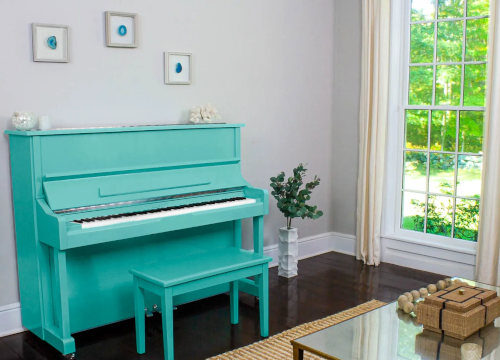
I’ve often wondered when the business model of piano buying would start to change. It seems like we feel comfortable purchasing everything from toothpaste to tires online and yet pianos are one thing that you still buy in a store. Well some of that is about to change. After speaking with Larry Caruso from Caruso Piano, they’re launching a brand of piano made specifically for online ordering. It’s called
Sonnova. I recently had the pleasure ...
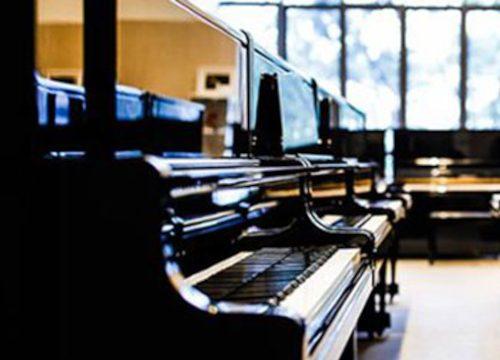
The thought of buying a piano can be exciting but it can also be a bit intimidating or daunting, especially if you don’t know anything about them. But have no fear, because at Piano Price Point, we’ve compiled so much of the data and written articles to make your job easier. To narrow down the scope of buying a piano, you first need to decide what kind of piano you’re looking for. Ask yourself these ...
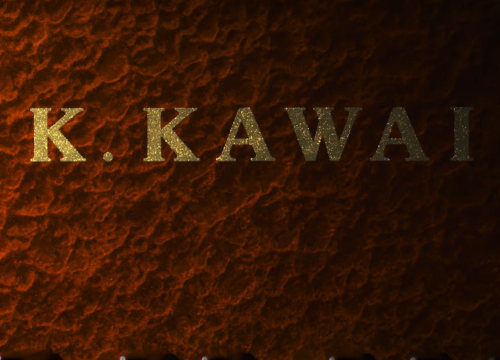
Money, apparently
does grow on trees or at least in ancient times it did. It's been recorded that rare tree sap was used as a form of payment for tax because it was deemed so valuable. This sap from the tree was harvested and refined into lacquer with incredible clarity and sheen. Many thousands of years ago, it was reserved for imperial palaces, religious temples and shrines. Early
examples have been dated to 7000BC. It ...